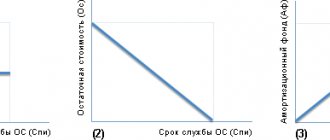Repair of fixed assets are actions carried out to reduce the degree of wear and tear and restore the technological capabilities of fixed assets in order to maintain them in an efficiently functioning state.
Fixed production assets must be used efficiently, and for this they need to be restored from time to time. This is possible in various ways: through modernization, reconstruction or repairs of varying degrees of duration and thoroughness.
By carrying out repairs as a result of investing certain costs, the value of the asset being repaired increases, that is, the operating efficiency increases.
Let's consider ways to repair fixed assets, analyze the features of its reflection in accounting.
How is repair different from reconstruction and modernization?
Since repairs, reconstruction and modernization are reflected differently in accounting and taxation, it is important to classify them correctly. The cost of restoration work does not matter to distinguish between such concepts. What matters here is the purpose for which such work is carried out (see table):
| Type of work | Target |
| Repair | Eliminate the malfunction that prevents the operation of the facility and restore functionality. At the same time, the properties of the object do not change (letter of the Ministry of Finance of Russia dated March 24, 2010 No. 03-03-06/4/29) |
| Modernization | Change the technological and service purpose of the object, improve some of the properties of the fixed asset. For example, in order to be able to work with it under increased loads (paragraph 2, paragraph 2, article 257 of the Tax Code of the Russian Federation) |
| Reconstruction | Rearrange the facility so that its capacity increases, the quality of products improves or its range becomes wider (paragraph 3, paragraph 2, article 257 of the Tax Code of the Russian Federation) |
To determine whether a property restoration is a renovation, renovation, or upgrade, refer to the following documents:
- Regulations on carrying out planned preventative repairs of industrial buildings and structures MDS 13-14.2000, approved by Decree of the USSR State Construction Committee dated December 29, 1973 No. 279;
- Departmental Construction Standards (VSN) No. 58-88 (R), approved by order of the State Committee for Architecture under the USSR State Construction Committee dated November 23, 1988 No. 312;
- by letter of the USSR Ministry of Finance dated May 29, 1984 No. 80.
This is stated in the letters of the Ministry of Finance of Russia dated March 24, 2010 No. 03-11-06/2/41, dated February 25, 2009 No. 03-03-06/1/87 and dated November 23, 2006 No. 03 -03-04/1/794.
Situation: can the work be considered a repair if, as a result, the characteristics of the fixed asset have improved? Before restoration, the main asset was faulty.
The answer to this question depends on the nature of the improvements.
In general, repairs are necessary precisely to restore the working condition of the property, and not to change its properties. If the characteristics of the fixed asset have improved, then the work may be considered reconstruction or modernization. That is why it is necessary to clearly define what the improvements are related to.
Work is recognized as repair work only if, as a result, properties change that are not related to the workload and technical and economic indicators of the object. In addition, it is important that such restoration does not affect the quality and range of products (works, services). Otherwise, the cost of restoration work will not meet the criteria for repair costs.
This conclusion follows from paragraph 2 of Article 257 of the Tax Code of the Russian Federation. A similar point of view is reflected in letters of the Ministry of Finance of Russia dated April 22, 2010 No. 03-03-06/1/289, dated December 29, 2009 No. 03-03-06/1/830, dated October 9, 2006 No. 03-03-04/4/156 and dated May 27, 2005 No. 03-03-01-04/4/67.
The courts share this position. Thus, if the work led to changes in the technical and economic indicators of the object and its purpose, then they cannot be considered repairs (see, for example, the determination of the Supreme Arbitration Court of the Russian Federation dated March 3, 2011 No. VAS-173/11).
By the way, there is an interesting position of the courts on replacing faulty parts of an object with more advanced or powerful ones. According to the arbitrators, this is not modernization. The main thing is that as a result of such a replacement, the technological or production purpose of the facility does not change. Even if performance characteristics improve, the costs of replacing faulty components and assemblies are recognized as repair costs. This position, for example, is expressed in resolutions of the Federal Antimonopoly Service of the Central District of February 9, 2010 No. A14-14803/2008/500/24, of the North-Western District of August 21, 2007 No. A56-20587/2006, of the Moscow District of August 14 2006 No. KA-A40/7489-06, Ural District dated June 7, 2006 No. F09-4680/06-S7).
Cheat sheets
It is clear that studying all the above documents requires a huge amount of time. Therefore, we have prepared special cheat sheets, using which you can quickly understand what kind of work has been done in your case. There are three such cheat sheets. One cheat sheet contains lists of works with their breakdown by type. The other is based on definitions given in various regulations. It contains general concepts that make it possible to understand the type of work “at the top level.” The third cheat sheet, dedicated to modernization, stands apart in this series. It contains signs of modernization and explanations for them.
When working with our cheat sheets, we suggest using the following algorithm.
First, based on the “modernization” cheat sheet, we decide whether our work relates to repair or whether it is a modernization.
Then, having made sure that we are talking about repairs, we must try to find the types of work being performed in the first table and, based on this, determine which repairs - current or major - they relate to.
If the necessary work is not in the first cheat sheet, then we turn to the second and try to apply the deductive method, extending the general definition to our private work.
Find out about the taxes paid by the counterparty and the violations committed by him Start an audit
Types of repairs
Repairs are classified as follows. Depending on who is doing the work: it can be repaired on its own (self-employed) or with the involvement of a contractor. And depending on the frequency and complexity, repairs can be current or major.
The first division is clear. And let's look at the second one in more detail. Typically, routine maintenance is the maintenance of fixed assets to keep facilities in working order. Major repairs involve replacing basic elements, parts, structures, etc.
You can determine which specific repairs are considered current and which major ones. In this case, you need to focus on documents developed by internal technical services (letter of the Ministry of Finance of Russia dated January 14, 2004 No. 16-00-14/10).
Results
OS repair consists of implementing measures aimed at maintaining the operability of fixed assets, but it should not lead to a change in the technical characteristics or purpose of the OS.
Repair costs are taken into account in expenses in the amount of actual amounts upon completion of repair work, regardless of whose forces the repair is carried out: in-house or outsourced. Documented justification for the need for repairs is required. In the NU it is permissible to create a reserve for repairs, but this leads to differences between the BU and the NU. You can find more complete information on the topic in ConsultantPlus. Free trial access to the system for 2 days.
What documents need to be used to justify the need for repairs?
The need for repairs can be confirmed by a report on identified faults and defects of the fixed asset, or a defect sheet. For some industries, standardized forms of such documents are provided. For example, defects in the handling and transport equipment of sea trade ports can be documented using a defect sheet, which was approved by Decree of the Ministry of Transport of Russia dated January 9, 2004 No. 2. Defects in the main elements of pipelines of thermal power plants are reflected in the sheet of pipeline defects (approved by Decree of the State Mining and Technical Supervision of Russia dated June 18, 2003 No. 94).
If there is no unified form of a document confirming the detected defects, then you can develop a form yourself. For example, an act on identified faults (defects) of a fixed asset item. The main thing is that this form contains all the required details. The report indicates the faults of the fixed asset and proposals for their elimination.
How many copies of the report on identified faults, defects of fixed assets or statements should be prepared? It all depends on who owns the property and who will do the repairs:
- if you repair your own property using your own means, that is, on your own, then one copy “for yourself” will be enough;
- when the work will be performed by contractors, draw up a document according to the number of participants. Representatives of all parties involved must sign each copy.
If you are repairing new equipment, the defects of which were identified during installation, then you need to record them in a report on the detected equipment defects. For example, according to form No. OS-16. This should be done in relation to objects that have not yet been registered as fixed assets.
"Modernization" cheat sheet
The main and fundamental difference between modernization, addition, reconstruction and repair is that it changes the operational performance of the building. For example, the capacity of engineering communications increases, corridors are expanded, and the like. That is, the building receives new properties, and its characteristics are qualitatively improved.
But it must be taken into account that the operational performance of a building may change during major (and even sometimes during current!) repairs. Therefore, it is important to take into account two more indicators: the scale of change and the goal. Thus, during repairs, improved performance is always a side effect associated with the use of modern materials and (or) technologies. This effect is not the purpose of the work being carried out and is optional. And in scale, such improvements are not comparable with the scale of all the work being carried out; in the estimate and schedule they do not occupy a leading role.
During reconstruction and modernization, on the contrary, improving performance is the main goal of the work carried out. They determine not only the choice of materials and technologies for carrying out work, but also the very need for this work. Accordingly, if the estimate and schedule for reconstruction and modernization contain some work related to repairs, then they are only secondary, caused by the need and type of modernization.
Thus, modernization (reconstruction, addition) can be distinguished from repair by the documents that are drawn up in connection with the work: technical specifications, justification, estimates, schedules, contracts. During modernization, the red thread in all these documents will be quality indicators. And during repairs - quantitative.
How to register the transfer of a fixed asset for repairs
Document the transfer of the object for repair. This will not have to be done only when the main asset is being repaired on site. This procedure follows from the instructions approved by Resolution of the State Statistics Committee of Russia dated January 21, 2003 No. 7.
When you transfer a fixed asset for repair to a special division of the organization, draw up an invoice for internal movement, for example, according to form No. OS-2.
If the repairs are carried out by a third-party organization with which a contract has been concluded, then the transfer of the object for repair is formalized, for example, with an act of acceptance and transfer of the object for repair. It can be compiled in any form. If the contractor suddenly loses or damages a fixed asset, the signed act will allow him to demand compensation for losses. If there is no act, then it will be difficult to prove the transfer of fixed assets to the contractor, as well as to demand compensation. This follows from articles 15, 702 and 714 of the Civil Code of the Russian Federation.
Cost accounting
Important! When the management of an organization makes an informed decision about the need to perform a major overhaul of the operating system, it is necessary to choose the appropriate method for carrying it out.
Typically, this activity can be carried out according to one of the following two approaches:
- restoration of a technical object using our own resources, that is, the internal resources of the enterprise itself;
- attracting resources from external (third-party) organizations through the conclusion of contract agreements.
Correct registration of all processes and procedures associated with the overhaul of fixed assets at an enterprise is of great importance for the correct accounting of relevant costs.
You should be aware that documentary evidence of the repairs carried out often becomes the object of close attention from tax officials.
At different stages of OS overhaul, the following documents must be drawn up:
- Justification of the need for this repair. For an OS object, an act of recording identified faults or, as an option, a defective statement is drawn up.
- If an object is transferred to the enterprise’s own division for repairs, an invoice is issued certifying the fact of internal movement.
- If the repair of a fixed asset is entrusted to an external organization, a corresponding contract and a certifying acceptance certificate are drawn up.
- The fact of completion of major repairs and return of the object to its intended place is also documented in the acceptance certificate.
- All paid expenses and incurred expenses must be confirmed by payment documents, estimate and technical documentation.
What documents should I use to formalize the acceptance of a restored fixed asset?
Acceptance of the repaired object is formalized by a special act. For example, according to form No. OS-3. It is filled out regardless of whether the repairs were carried out internally or by contract. Only in the first case do they fill out the form in one copy, and in the second - in two (for themselves and for contractors).
The act is signed by:
- members of the selection committee created by the owner of the property;
- an employee responsible for the repair of fixed assets or a representative of the contractor;
- employee responsible for the safety of fixed assets after repairs.
After this, the act is approved by the head. Next, the document is handed over to the accountant.
After receiving the report, reflect the information about the repairs carried out in the inventory card for recording the fixed asset or in the inventory book (intended for small businesses). To do this, you can use standard forms No. OS-6, No. OS-6a or No. OS-6b. This is stated in the instructions approved by Resolution of the State Statistics Committee of Russia dated January 21, 2003 No. 7.
When accepting buildings, structures or premises after construction and installation work, additional paperwork must be completed. Namely, the acceptance certificate in form No. KS-2 and a certificate of the cost of work performed and expenses in form No. KS-3. These forms were approved by Decree of the State Statistics Committee of Russia dated November 11, 1999 No. 100.
By the way, if parts were changed during the repair process, then you will need to draw up an act for replacing spare parts of the fixed asset. There is no standard form for such a document, so it can be drawn up in any form (Part 1, Article 9 of Law No. 402-FZ of December 6, 2011).
Advice : to simplify document flow, acts on the replacement of spare parts in fixed assets can be drawn up at the end of the month for each performer of work.
Situation: is it necessary to draw up an act of acceptance and delivery of a fixed asset during self-repair, for example, according to form No. OS-3?
Answer: no, it is not necessary if the main asset was not transferred to other departments during repairs.
This is explained by the fact that it is necessary to draw up acceptance certificates only when moving fixed assets from the customer to the contractor and vice versa. For example, if the object was transferred for repair to a contractor or to the organization’s repair service.
If, during repairs, the location of the object does not change, when the repairs are carried out directly “on the spot,” then acceptance and transfer of the fixed asset does not occur.
Situation: is it necessary to indicate in the act in form No. OS-3 the cost of materials used by the contractor to repair the fixed asset? The organization handed over spare parts to the contractor for repairs.
Answer: no, it is not necessary.
Form No. OS-3 is used for the acceptance and delivery of fixed assets from repairs (instructions approved by Resolution of the State Statistics Committee of Russia dated January 21, 2003 No. 7). Section 2 indicates the contractual cost of repairs. And the contractor must indicate the composition and cost of spare parts for the repair of fixed assets in the report on the materials consumed (Article 713 of the Civil Code of the Russian Federation).
OS overhaul in accounting - postings
Once the decision on the need for a major overhaul of fixed assets has been made, the facility can be restored by the organization itself or by using equipment and workers from a third-party company on a contract basis. If you go the route of overhaul by the organization’s services, then you need to take into account that expenses will include the cost of spare parts and materials, wages, and insurance premiums.
Accounts for carrying out major repairs in various ways will be as follows:
- if there is a structural unit (repair service):
Dt 23 Kt 10 (16, 69, 70) - repair costs collected;
Dt 20 (25, 26, 29, 44) Kt 23 - expenses are written off depending on the use of the operating system (the account on which depreciation is recorded is debited);
- if there is no repair service, account 23 is not used, and the costs are written off directly to the cost account:
Dt 20 (25, 26, 29, 44) Kt 10 (16, 69, 70);
- If the repair is carried out by a contractor, the cost entry will be:
Dt 20 (25, 26, 29, 44) Kt 60.
For long-term overhauls, it is recommended to transfer objects to a separate subaccount of account 01 “OS under repair”.
The recommendations of ConsultantPlus experts will help you write off materials for OS repairs in accounting and for income taxes. Get free trial access to the system and go to the Ready-made solution.







